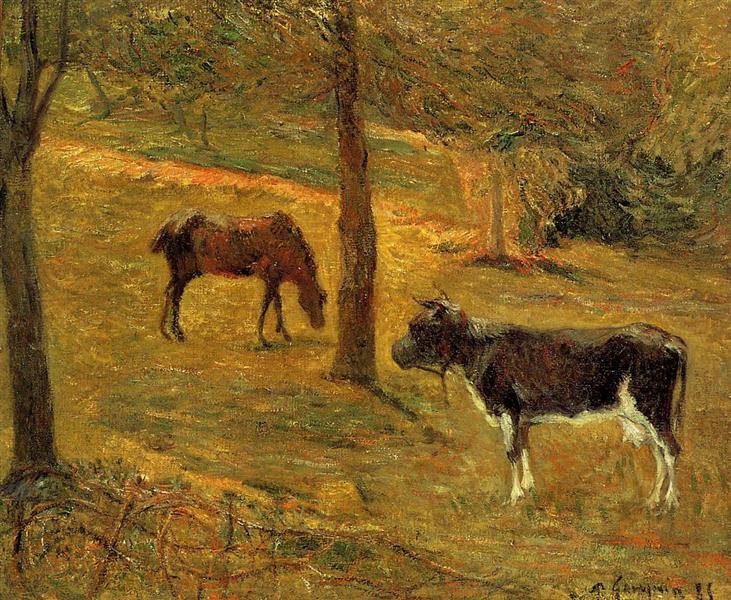Opis
Paul Gauguin's painting "Horse and Cow in a Meadow", created in 1885, stands out as a work that encapsulates the transformation of art at the threshold of Post-Impressionism. In this pastoral depiction, Gauguin introduces us to an idyllic landscape that is situated in both a realistic and symbolic sense, revealing his interest in nature and the everyday. The work shows in the foreground a horse and a cow grazing in the middle of a meadow, elements that, although common, are treated with the distinctive grace of his emerging style.
The composition of the work is carefully structured, avoiding the rigidity of classical symmetry, but at the same time achieving a balance that catches the eye. The horse, of large proportions and with a palette that combines brown tones, makes a vigorous contrast with the cow of lighter shades. This choice of colors is not accidental; the earthy tones reverberate with the essence of the rural landscape, while the use of shadows and volumes suggests a soft and enveloping light, which adds an almost nostalgic atmosphere to the scene.
The elements of the meadow, represented through an almost abstract treatment of the grass, display a loose, gestural brushwork that aligns with the visual innovations explored by Gauguin and his contemporaries. The vegetation becomes a vibrant field of colour that enlivens the work and adds an emotional dimension, suggesting a world where the natural has an intrinsic value that transcends the merely representational. Through this luminous meadow, Gauguin seems to invite the viewer to reflect on the relationship between humans and nature, a recurring theme in his later career.
Gauguin, who was one of the pioneers in the use of choreography of colour and simplification of forms, moves away from literal representation in this work. His ability to transform the most conventional elements into visual poetry is clearly evidenced in the way he presents the animals. Each figure, in its arrangement in space, is treated with a sense of dignity and presence that is often lost in more academic art. Here, the horse and the cow are not merely animals in a landscape; they become actors on a stage charged with meaning.
In this sense, "Horse and Cow in a Meadow" can be seen as one of Gauguin's first explorations into a more symbolic and expressive art, where the visual merges with the emotional. This work anticipates his later explorations in places like Tahiti, where color, shape and subject matter dissolve into a completely new visual language. Despite its apparent simplicity, this work demonstrates the growing complexity of his technique and the beginning of his search for the mystical and spiritual in art.
The painting is set against the backdrop of a Europe that was undergoing radical changes in the perception of art and nature. During this decade, several artists, including Van Gogh and Cézanne, were also beginning to reconfigure how the rural environment was represented. However, Gauguin's work, in particular this one, stands out for its sensitivity to the symbolism of the elements depicted and for a more intuitive and emotional approach that sets it apart from its contemporaries. "Horse and Cow in a Meadow" is, in short, a work that not only captures a moment in time, but also foreshadows an era in which art would begin to break free from traditional structures, seeking new horizons of expression.
KUADROS ©, a famous painting on your wall.
Hand-made oil painting reproductions, with the quality of professional artists and the distinctive seal of KUADROS ©.
Painting reproduction service with satisfaction guarantee. If you are not completely satisfied with the replica of your painting, we will refund 100% of your money.

